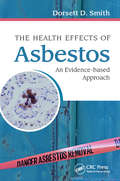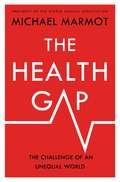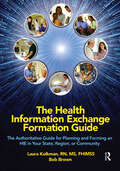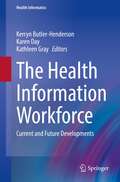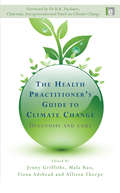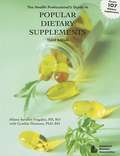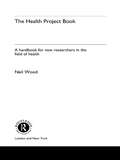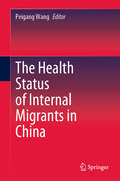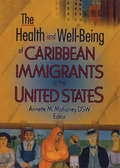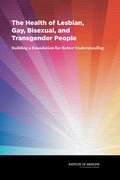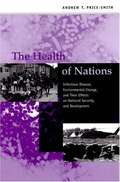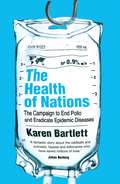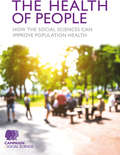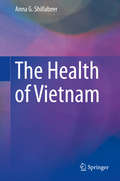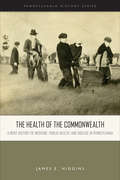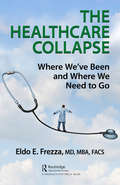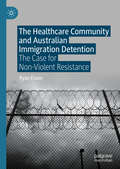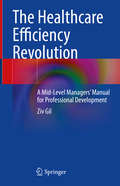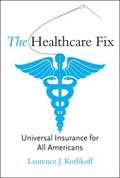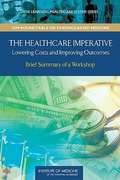- Table View
- List View
The Health Debate 2nd edition (Policy and Politics in the Twenty-First Century)
by David J. HunterHealth care systems everywhere face multiple pressures from changing demography, the rise of non-communicable disease, the growing demand on health services, and limited resources at a time of austerity. Focusing on the British NHS from a political science perspective, this second edition of this best-selling book offers a fresh look at how it is coping with such pressures. The book explores the complexity of health policy and health services, offering a critical perspective on concerns including integrated care, the return of public health to local government and moves to devolve health services to local level. Crucially, it offers a critique of the market-style changes introduced by the Coalition government between 2010 and 2015. Students of health care and health policy, policy-makers and public health and health care professionals will find this lively and accessible reassessment of NHS reforms invaluable.
The Health Effects of Asbestos: An Evidence-based Approach
by Dorsett D. SmithThe health-related effects of asbestos have long been mired in controversy, with industry and plaintiff attorneys playing a significant role. This comprehensive book provides a balanced and extensive evidence-based critical analysis of the literature concerning asbestos-related diseases, from a scientific and historical perspective. The book presen
The Health Gap: The Challenge of an Unequal World
by Michael Marmot<p>In this groundbreaking book, Michael Marmot, president of the World Medical Association, reveals social injustice to be the greatest threat to global health <p>In Baltimore’s inner-city neighborhood of Upton/Druid Heights, a man’s life expectancy is sixty-three; not far away, in the Greater Roland Park/Poplar neighborhood, life expectancy is eighty-three. The same twenty-year avoidable disparity exists in the Calton and Lenzie neighborhoods of Glasgow, and in other cities around the world. <p>In Sierra Leone, one in 21 fifteen-year-old women will die in her fertile years of a maternal-related cause; in Italy, the figure is one in 17,100; but in the United States, which spends more on healthcare than any other country in the world, it is one in 1,800. Why? <p>Dramatic differences in health are not a simple matter of rich and poor; poverty alone doesn’t drive ill health, but inequality does. Indeed, suicide, heart disease, lung disease, obesity, and diabetes, for example, are all linked to social disadvantage. In every country, people at relative social disadvantage suffer health disadvantage and shorter lives. Within countries, the higher the social status of individuals, the better their health. These health inequalities defy the usual explanations. Conventional approaches to improving health have emphasized access to technical solutions and changes in the behavior of individuals, but these methods only go so far. What really makes a difference is creating the conditions for people to have control over their lives, to have the power to live as they want. Empowerment is the key to reducing health inequality and thereby improving the health of everyone. Marmot emphasizes that the rate of illness of a society as a whole determines how well it functions; the greater the health inequity, the greater the dysfunction. <p>Marmot underscores that we have the tools and resources materially to improve levels of health for individuals and societies around the world, and that to not do so would be a form of injustice. Citing powerful examples and startling statistics (“young men in the U.S. have less chance of surviving to sixty than young men in forty-nine other countries”), The Health Gap presents compelling evidence for a radical change in the way we think about health and indeed society, and inspires us to address the societal imbalances in power, money, and resources that work against health equity.</p>
The Health Handbook for Schools
by Adrian Brooke Steve WeltonThis handbook allows rapid reference to conditions commonly encountered in school-aged children, and to rare diseases as well. It focuses particularly on the impact of the condition on the child's ability to access the curriculum, and suggests educational approaches that should help. In this way it is hoped that education and medicine can work hand in hand to allow each child to achieve their potential. The book offers: essential information on medical conditions and the way they affect learning; up-to-date descriptions of symptoms, signs and current key concepts; current educational approaches taken to accommodate children with the conditions and problems listed; and advice on diagnosing and responding to acute illness such as meningitis (what to do with a child who might have it, what happens to the rest of the school if it is diagnosed in one child).
The Health Impact of Smoking and Obesity and What to Do About It
by David Mclean Hans Krueger Dan Williams Barbara KaminskyDespite significant progress due to public health campaigns and other policy efforts, smoking continues to be a serious health threat throughout the world. In addition, sedentary lifestyles, poor diet, and obesity continue to be major causes of chronic diseases. The Health Impact of Smoking and Obesity and What to Do about It synthesizes a vast quantity of recent data on the benefits and cost-effectiveness of both clinical and public health interventions in addressing the risk factors of smoking and obesity.A large proportion of chronic disease is preventable. The Health Impact of Smoking and Obesity and What to Do about It provides solid evidence and practical advice to health care planners, decision-makers, and frontline providers alike. The volume discusses various approaches to measuring disease burden and setting health care targets, and provides a summary of interventions of proven effectiveness. Taking into account the vital lessons learned from the experience of tobacco control over forty years, and focusing on the current state of the evidence for obesity control, the study stresses the importance of comprehensive strategies that deal with both individual behaviour changes and the need to encourage social contexts that enhance healthy choices and lifestyles.
The Health Information Exchange Formation Guide: The Authoritative Guide for Planning and Forming an HIE in Your State, Region or Community (HIMSS Book Series)
by Bob Brown Laura KolkmanWinner of HIMSS 2011 Book of the Year Award!The HIMSS Book of the Year Award honors a book that offers outstanding practical guidance and/or strategic insight for healthcare information and management systems professionals. "The electronic exchange of health information is an essential capability that contributes to improved efficiency and patient outcomes in the healthcare delivery process. This book provides readers with the tools and resources needed to establish a successful, sustainable HIE and avoid many of the pitfalls that failed early initiatives. The authors use their own direct experience as HIE consultants, their interviews with HIE leaders and extensive research to offer a practical, step-by-step approach to forming an HIE. The book features case studies, examples, checklists, references, a high-level history and overview of HIE and a discussion of why HIE is so important. The book also describes in detail the essential steps to planning and forming a successful HIE. By providing the necessary tools and framework, the book serves to advance the successful development of HIEs and improve efficiency and outcomes in the healthcare delivery process. During a time of unprecedented change in the healthcare landscape, this guide is a timely and valuable resource for those seeking to leverage HIE to achieve quality gains and billions of dollars in saving under healthcare reform."
The Health Information Workforce: Current and Future Developments (Health Informatics)
by Karen Day Kathleen Gray Kerryn Butler-HendersonThis book provides a detailed guide to the highly specialised but little known health information workforce - people who are health informaticians, digital health experts, and managers of health data, health information and health knowledge. It explains the basis of their unique functions within healthcare – their educational pathways and standards, professional qualifications and industry certifications, scholarly foundations and principles of good practice. It explores their challenges, including the rise of the health consumer movement, the drive to improve equity and quality in healthcare, new technologies such as artificial intelligence, and the COVID-19 infodemic. Case studies describe how practitioners in real-world roles around the world are addressing the digital transformation of health. The Health Information Workforce: Current and Future Developments offers insights into a skilled group of people who are essential for healthcare services to function, for care providers to practice at the top of their scope, for researchers to generate significant insights, and for care consumers to be empowered participants in health systems. This book offers new perspectives for anyone working or intending to work in the health sector. It is a critical resource for health workforce planners, employers and educators seeking guidance on the specialised capabilities needed for high performance in an increasingly information-intensive sector.
The Health Practitioner's Guide to Climate Change: Diagnosis and Cure
by Jenny Griffiths Fiona Adshead Mala Rao Allison ThorpeHighly commended in the Public Health category, BMA Medical Awards 2010 There are enormous health benefits from tackling climate change. This is the first book to set out what health practitioners can do to prevent the worst impacts of climate change, to make health services sustainable, and to design healthy, sustainable communities. The book: - provides an introduction for health practitioners and students to climate change and its current and future health impacts - describes the relationship between health and the environment - gives facts and figures on greenhouse gas emissions - sets out the huge benefits to health of acting on climate change - explains what health practitioners can do - at home, at work and in their organizations, and - shows how you can support action in communities, nationally and globally. Essential reading for: - health professionals, local government, built environment professionals - students across all sectors of health, medicine and public administration - community and voluntary sector, NGOs - the business community involved in private healthcare. The Health Practitioner's Guide to Climate Change is written by an authoritative group of authors from key organisations in the field, including the Met Office, the Faculty of Public Health, Natural England, the London School of Hygiene and Tropical Medicine, the Climate and Health Council, the NHS Sustainable Development Unit, the Health Protection Agency, the University of the West of England, Sustrans and the National Social Marketing Centre. Sponsored by The National Heart Forum and the National Social Marketing Centre. Foreword by Dr. R.K. Pachauri, Director General, The Energy and Resources Institute (TERI) and Chairman, Intergovernmental Panel on Climate Change (IPCC)
The Health Professional's Guide to Popular Dietary Supplements (Third Edition)
by Allison Sarubin-Fragakis Cynthia ThomsonTwenty-nine new dietary supplements have been added to this edition! This guide comprehensively explores the media claims, drug-supplement interactions, dosage information and relevant research for more than 100 of today's most popular dietary supplements. Completely revised, updated, and indexed information is provided for dietetics professionals and their clients. Written by industry experts, this guide's recommendations are reliable and backed by credible clinical research.
The Health Project Book: A Handbook for New Researchers in the Field
by Dr Neil Wood Neil WoodThe Health Project Book is a practical and detailed guide to all aspects of conducting a research project in health. It is relevant to anyone working in the health field who needs to design a study, collect the data, analyse the findings and write up a report. Clear advice and examples are given in each of these areas.Case studies illustrate the use of:* CD-Rom Facilities* the Cochrane database on the world wide web* qualitative analysis software.Individual chapters cover:* ethical considerations* the selection of samples* questionnaire design* working in a laboratory* conducting interviews* statistical and qualitative analysis.Further advice is included on how to write a research paper critically, and how to make effective verbal presentations of findings.Neil Wood has supervised student projects in health over many years and this handbook is based on his experience in teaching students how to get the best out of themselves and their project. It will be an extremely useful resource for students and professionals in nursing, health studies, health sciences, psychology and related fields.
The Health Status of Internal Migrants in China
by Peigang WangThis book describes the health status of internal migrants in China and explores a number of related factors, which include their physical health, mental health, fertility, social integration, the current state of basic public health services in China and so on. At present, there are 245 million migrants working in China, which means 1 out of every 6 people is a migrant. The large scale of the migrant population is accompanied by a range of problems concerning e.g. public health and medical services. This book draws on the latest findings and data to describe and analyze the health status of migrants in China from three perspectives – population distribution, time distribution and spatial distribution – and each chapter employs various advanced statistical methods, such as multilevel modeling and propensity score matching. Given the in-depth information it provides, the book will appeal to managers, clinicians, and researchers from many fields. It shares valuable insights into the health status of and related factors concerning China’s internal migrants, while also providing a sound scientific basis for decision-makers.
The Health and Well-Being of Caribbean Immigrants in the United States
by Annette MahoneyThe Health and Well-Being of Caribbean Immigrants in the United States is a timely addition to the knowledge base concerning the integration of this population into the fabric of American society. On the eve of the fortieth anniversary of the 1965 Immigration Reform Act, this book examines the relationship between immigrants from the Caribbean and the culture of the United States. This body of work provides resources for scholars and researchers and provides instrumental strategies for use in practice by counselors/social workers, curriculum developers, and immigration analysts.With this book, you will develop a new appreciation for the social capital immigrants bring with them, their adaptation to their new society, and the extent to which their distinctive characteristics promote or hinder their social mobility. Using tables, figures, and graphs, The Health and Well-Being of Caribbean Immigrants in the United States provides thorough analyses of broad-ranging issues and proposes viable solutions to the problems these immigrants face.In this important resource, expert educators, researchers, and community leaders address the unique challenges that affect this population, including: increased infant mortality rates increased HIV/AIDS among the Caribbean community the growing trend of violence and abuse among Caribbean and Caribbean-American youths the special needs of aging and elderly immigrants living in the United States the impact of the 1996 immigration legislation on Caribbean familiesThe Health and Well-Being of Caribbean Immigrants in the United States paints a clear picture of how these citizens are coping with the social, economic, and political aspects of the American way of life. This guide offers new findings and insight into the reality of the diverse immigrant Caribbean population, setting the stage for establishing groundbreaking initiatives to develop better support services. Innovative community-based approaches and culturally specific prescriptive intervention models make this book an integral source for social scientists, human service professionals, and policymakers.
The Health of Lesbian, Gay, Bisexual, and Transgender People: Building a Foundation for Better Understanding
by Institute of Medicine of the National AcademiesAt a time when lesbian, gay, bisexual, and transgender individuals--often referred to under the umbrella acronym LGBT--are becoming more visible in society and more socially acknowledged, clinicians and researchers are faced with incomplete information about their health status. While LGBT populations often are combined as a single entity for research and advocacy purposes, each is a distinct population group with its own specific health needs. Furthermore, the experiences of LGBT individuals are not uniform and are shaped by factors of race, ethnicity, socioeconomic status, geographical location, and age, any of which can have an effect on health-related concerns and needs. The Health of Lesbian, Gay, Bisexual, and Transgender People assesses the state of science on the health status of LGBT populations, identifies research gaps and opportunities, and outlines a research agenda for the National Institute of Health. The report examines the health status of these populations in three life stages: childhood and adolescence, early/middle adulthood, and later adulthood. At each life stage, the committee studied mental health, physical health, risks and protective factors, health services, and contextual influences. To advance understanding of the health needs of all LGBT individuals, the report finds that researchers need more data about the demographics of these populations, improved methods for collecting and analyzing data, and an increased participation of sexual and gender minorities in research. The Health of Lesbian, Gay, Bisexual, and Transgender People is a valuable resource for policymakers, federal agencies including the National Institute of Health (NIH), LGBT advocacy groups, clinicians, and service providers.
The Health of Nations: Infectious Disease, Environmental Change, and Their Effects on National Security and Development
by Andrew T. Price-SmithSmith investigates the influence of infectious disease on nations' stability and prosperity. He also provides a theoretical and empirical foundation for the emerging field of health security.
The Health of Nations: The Campaign to End Polio and Eradicate Epidemic Diseases
by Karen Bartlett&‘Hope lies in dreams, in imagination, and in the courage of those who dare to make dreams into reality.&’ – Jonas Salk, inventor of one of the first successful polio vaccines No one will die of smallpox again… One of the worst killers ever is now consigned to history – perhaps the greatest humanitarian achievement of our age. Now polio, malaria and measles are on the hit list. Karen Bartlett tells the dramatic story of the history of eradication and takes us to the heart of modern campaigns. From high-tech labs in America to the poorest corners of Africa and the Middle East, we see the tremendous challenges those on the front lines face every day, and how they take us closer to a brave new world.
The Health of People: How the social sciences can improve population health
by Campaign for Social ScienceAs Britain ages amid austerity, more and more people will suffer from long-term health conditions. Obesity and diabetes are on the rise. Mental health problems are widespread. Tobacco and addictions are well-known killers. Each condition brings high costs, both financial and social. Meanwhile, budgets for the NHS, social care and public health are being squeezed. Despite this potential crisis, new opportunities are emerging to support both healthcare providers and the population. Advances in understanding will change how behaviour can prevent and mitigate ill health. Our approach to health must become more ‘social’. The Health of People – a report compiled by the Campaign for Social Sciences – investigates a range of ways to cut the cost of health interventions and to improve patient outcomes as well as ways of preventing people becoming patients. The report includes arguments for and case studies in favour of a more rounded, social science informed view of health and wellbeing. It concludes with an invitation to clinicians and policy makers to think outside the box of ‘care’ about the causes and prevention of ill health.
The Health of People: How the social sciences can improve population health
by Campaign for Social ScienceAs Britain ages amid austerity, more and more people will suffer from long-term health conditions. Obesity and diabetes are on the rise. Mental health problems are widespread. Tobacco and addictions are well-known killers. Each condition brings high costs, both financial and social. Meanwhile, budgets for the NHS, social care and public health are being squeezed. Despite this potential crisis, new opportunities are emerging to support both healthcare providers and the population. Advances in understanding will change how behaviour can prevent and mitigate ill health. Our approach to health must become more ‘social’. The Health of People – a report compiled by the Campaign for Social Sciences – investigates a range of ways to cut the cost of health interventions and to improve patient outcomes as well as ways of preventing people becoming patients. The report includes arguments for and case studies in favour of a more rounded, social science informed view of health and wellbeing. It concludes with an invitation to clinicians and policy makers to think outside the box of ‘care’ about the causes and prevention of ill health.
The Health of Vietnam
by Anna G. ShillabeerThis book presents a detailed overview of the healthcare environment in Viet Nam. Given the general lack of understanding of healthcare in the Vietnamese context, it discusses the background and history, current status and the future of healthcare in the country. The first part of the book provides a summary of the current state of Vietnamese healthcare, incorporating discussions on the training and professional practice environment and the development, implementation and impact of national insurance policies. In addition, it highlights the cultural aspects of health provision and behaviours, technology integration and health trends from a number of angles based on standard global reporting dimensions. The second part elaborates on the 5-year strategic plan for national healthcare management and the top 5 barriers to meeting these planned objectives. It documents key investors and project objectives and outcomes, as well as the top 10 health issues in Vietnam including an overview of national and international initiatives to tackle these issues, addressing financial and social burdens in the process. In the third part, the book outlines the opportunities and barriers for improvement in healthcare outcomes for Viet Nam, providing evidence to support future work by local or international researchers. It is a fundamental text for anyone looking to work or research in the Vietnamese healthcare environment and provides an outline for project planning and targeted programs of work to achieve measureable improvements in Viet Nam.
The Health of the Commonwealth: A Brief History of Medicine, Public Health, and Disease in Pennsylvania
by James E. Higgins“The history of medicine in Pennsylvania is no less vital to understanding the state’s past than is its political or industrial history,” writes James Higgins in The Health of the Commonwealth, his overview of medicine and public health in the state. Covering the outbreak of yellow fever in 1793 through the 1976 Legionnaire’s Disease epidemic, and the challenges of the present day, he shows how Pennsylvania has played a central role in humanity’s understanding of—and progress against—disease. Higgins provides close readings of specific medical advances—for instance, scientists at the University of Pittsburgh discovered the polio vaccine—and of disease outbreaks, like AIDS. He examines sanitation and water purification efforts, allopathic medicine and alternative therapies, and the building of the state’s tuberculosis sanitaria. Higgins also describes Native American and pre-modern European folk medicine, the rise of public health in the state, and women’s roles in both folk and scientific medicine. The Health of the Commonwealth places Pennsylvania’s unique contribution to the history of public health and medicine in a larger narrative of health and disease throughout the United States and the world.
The Healthcare Collapse: Where We've Been and Where We Need to Go
by Eldo FrezzaThe evolution of the healthcare system in the U.S. has seen numerous changes in the last 30 years where fee-for-service was the mainstay of reimbursement models and hospitals were managed by physicians and patient care was key. The early 1990’s saw the emergence of HMOs and other managed care models with physicians handing over leadership roles to corporate entities whose main concern was the bottom line and profitability while patient care and satisfaction suffered. The Healthcare Collapse: Where We’ve been and Where We Need to Go explores the low morale of physicians in this corporate healthcare culture as well as the expansion of hospitals owned by corporations. The author focuses on recovering healthcare morals and return value to the individuals who provide active care and not just business. This book also examines the possible repercussions of Medicare and Medicaid while address the question of single payer healthcare. This book looks at where healthcare has been, what has worked and what hasn’t, and recommends solutions to create a system that focuses on the patient and providing quality care in this age of reimbursement cuts, demands for better technology and providing a safer environment for both the patient and clinicians who work in hospitals. The author also advocates for a shift in management and recommends hospitals leaders engage physicians and other clinicians in process improvement and other initiatives which can result in a more efficient system – one where quality patient care dominant. The book also outlines programs which can be championed by hospitals such as patient engagement activities, community health and other outreach and education programs.
The Healthcare Community and Australian Immigration Detention: The Case for Non-Violent Resistance
by Ryan EssexAustralia has one of the harshest immigration detention regimes in the world, labelled cruel and degrading and a crime against humanity; these policies have been widely condemned. This book calls for a shift in how the healthcare community approaches Australian immigration detention, calling for non-violent resistance to be incorporated in future efforts that seek change. Fundamentally, such an approach recognizes that if change is to be realized a shift is needed beyond evidence and reasoned argument; future efforts need to confront injustice, resisting and undermining what creates and sustains these policies. This book provides a rationale for such action and considers the justification of three different ‘types’ of action in detail; strike action, whistleblowing and principles disobedience.
The Healthcare Efficiency Revolution: A Mid-Level Managers’ Manual for Professional Development
by Ziv GilIn recent years, improving efficiency in healthcare facilities in general, and in hospitals specifically, has become increasingly important. This book provides essential information on the powerful performance results that can be achieved when patient-centered efficiency reforms are implemented within health management systems. Created for departmental and institutional healthcare professionals, this book offers intuitive guidelines, technical tools, and work procedures to comprehensively analyze all aspects of current operations and reconfigure assets in pursuit of serving more patients, reducing costs, and generating revenues. This work is particularly valuable as its focuses on the most basic service unit in any given hospital (department/unit) and on methodologies for enhancing management practice and creating internal cultures of continual change and ongoing development. The book provides effective and lasting solutions that reduce E.R. and physician consultation wait times, complications and hospital readmissions, and laboratory tests performed, as well as increase O.R. productivity, annual numbers of patients served, and overall rates of staff and patient satisfaction. Also addressed are how best to handle moments of crisis (such as COVID-19); ethical and legal concerns; and the hiring, development, promotion, and empowerment of staff. Dedicated sections analyze ways to minimize disruptive behavior among physicians, nurses, and other personnel, and present strategies for improving department meetings, particularly in an era of social distancing. The book also describes how to maximize outcomes through multi-disciplinary approaches, the use of core performance metrics, ongoing data collection and analysis, simple reporting protocols, transparency, and the adoption of technological aids, including dedicated apps. Everything presented in this work has been put into practice. They achieved substantial and sustainable improvements in service delivery – all with little or no change in staff, budgets, and other resources already at hand. This book will help specialists and medical managers in the healthcare market to more effectively use their own resources to achieve levels of performance and success objectives they might otherwise have thought were unattainable.
The Healthcare Fix: Universal Insurance for All Americans
by Laurence J. KotlikoffKotlikoff proposes a simple, straightforward approach to the problem that would create one system that works for everyone and secure America's fiscal and economic future. His proposed Medical Security System is not the socialized medicine so feared by Republicans and libertarians.
The Healthcare Fix: Universal Insurance for All Americans (The\mit Press Ser.)
by Laurence J. KotlikoffA simple, straightforward, and foolproof proposal for universal health insurance from a noted economist.The shocking statistic is that forty-seven million Americans have no health insurance. When uninsured Americans go to the emergency room for treatment, however, they do receive care, and a bill. Many hospitals now require uninsured patients to put their treatment on a credit card which can saddle a low-income household with unpayably high balances that can lead to personal bankruptcy. Why don't these people just buy health insurance? Because the cost of coverage that doesn't come through an employer is more than many low- and middle-income households make in a year. Meanwhile, rising healthcare costs for employees are driving many businesses under. As for government-supplied health care, ever higher costs and added benefits (for example, Part D, Medicare's new prescription drug coverage) make both Medicare and Medicaid impossible to sustain fiscally; benefits grow faster than the national per-capita income. It's obvious the system is broken. What can we do?In The Healthcare Fix, economist Laurence Kotlikoff proposes a simple, straightforward approach to the problem that would create one system that works for everyone and secure America's fiscal and economic future. Kotlikoff's proposed Medical Security System is not the "socialized medicine" so feared by Republicans and libertarians; it's a plan for universal health insurance. Because everyone would be insured, it's also a plan for universal healthcare. Participants—including all who are currently uninsured, all Medicaid and Medicare recipients, and all with private or employer-supplied insurance—would receive annual vouchers for health insurance, the amount of which would be based on their current medical condition. Insurance companies would willingly accept people with health problems because their vouchers would be higher. And the government could control costs by establishing the values of the vouchers so that benefit growth no longer outstrips growth of the nation's per capita income. It's a "single-payer" plan, but a single payer for insurance. The American healthcare industry would remain competitive, innovative, strong, and private.Kotlikoff's plan is strong medicine for America's healthcare crisis, but brilliant in its simplicity. Its provisions can fit on a postcard and Kotlikoff provides one, ready to be copied and mailed to your representative in Congress.
The Healthcare Imperative: Lowering Costs and Improving Outcomes - Workshop Series Summary
by Institute of Medicine of the National AcademiesThe United States has the highest per capita spending on health care of any industrialized nation but continually lags behind other nations in health care outcomes including life expectancy and infant mortality. National health expenditures are projected to exceed $2.5 trillion in 2009. Given healthcare's direct impact on the economy, there is a critical need to control health care spending. According to The Health Imperative: Lowering Costs and Improving Outcomes, the costs of health care have strained the federal budget, and negatively affected state governments, the private sector and individuals. Healthcare expenditures have restricted the ability of state and local governments to fund other priorities and have contributed to slowing growth in wages and jobs in the private sector. Moreover, the number of uninsured has risen from 45.7 million in 2007 to 46.3 million in 2008. The Health Imperative: Lowering Costs and Improving Outcomes identifies a number of factors driving expenditure growth including scientific uncertainty, perverse economic and practice incentives, system fragmentation, lack of patient involvement, and under-investment in population health. Experts discussed key levers for catalyzing transformation of the delivery system. A few included streamlined health insurance regulation, administrative simplification and clarification and quality and consistency in treatment. The book is an excellent guide for policymakers at all levels of government, as well as private sector healthcare workers.

